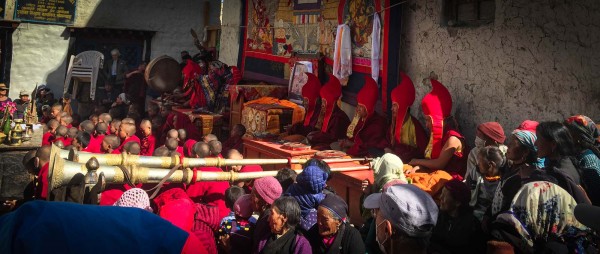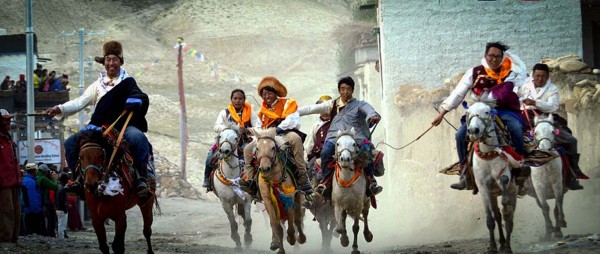Important Information
Region
Mustang Region Treks
Duration
18 Days
Max Altitude 3750 Meters
Best Season Spring, Summer & Autumn
Activity Per Day
4-5 Hours Walk
Grade
Level 3
Group Size
2 - 12 people
Transportation Bus/Flight
Lower Mustang trek takes place in the Mustang district within the classical Annapurna circuit route. Lower mustang lies between Dhaulagiri and Annapurna Mountain where the Kali Gandaki River flows and formed the deep gorge which is one of the deepest gorges in the world. This specific area is also known for Thak Khola in the past during the salt trading between Nepal and Tibet. Trekking permits here are very much cheaper as compared with the Upper Mustang where you need Annapurna conservation entrance permit (ACAP) and a TIMs Card. It is suitable for all kinds of hikers or trekkers to trek in lower mustang as it is short and moderate. Although the best time to visit mustang is during spring and autumn, it is possible to do trek even in the monsoon season because of the rain shadow area.
Lower Mustang trek offers a glimpse of Tibet as the culture, people, religion and even the landscape is similar to the Guge Kingdom of western Tibet. This hidden valley offers beautiful sceneries of Dhaulagiri icefall, pristine Titi Lake, vistas of snow-capped Nilgiri, and the Thak Khola valley. In terms of religion, Muktinath is the holiest site here for both Buddhist and Hindu. Traditional houses in the villages look like stone masonry, and monasteries, Mane wheels, and Chortens are seen in every village. Even Apple orchids are beautifully grown especially in Marpha village. Do not forget to try apple pie and Marpha brandy made from a variety of fruits such as pear, apricot, apple, etc. Every corner of this valley has its own unique features to attract tourists.
Lower Mustang Trek Routes:
Lower Mustang trek route is prepared based on the exploration of Mustang culture and its surrounding attraction like stunning mountains, pristine lakes, etc. This trek starts by taking a flight over the deepest Kali Gandaki gorge to Jomsom from Pokhara. The actual trek begins from the town of Jomsom to Kagbeni and further to Muktinath via Jharkot. After three days of the trek, you will trek to Lupra (only Bon village in Mustang), untouched village of Phalyak, Thini (foothill village of Nilgiri), Chimang, Kalopani, Dhaulagiri icefall of Larjung and Marpha village. The trek ends in Jomsom and flies back to Pokhara.
If you are looking for a different itinerary than the itinerary here, please Customize Your Trip.
Lower Mustang Trek short Itinerary:
Day 01: Arrival to Kathmandu (1300m)
Day 02: Overland drive to Pokhara (827 m)
Day 03: Fly from Pokhara to Jomsom (2,720 m) & Trek to Kagbeni (2,810 m)
Day 04: Trek to Jharkot village (3,550 m)
Day 05: Trek to Muktinath (3,760 m)
Day 06: Trek to Lupra village (3,668 m)
Day 07: Trek to Phalyak (3,229 m)
Day 08: Trek to Thini village (2,840 m) & Side Hike to Dhumba Tal (2,830 m)
Day 09: Trek to Chimang village (2,850 m)
Day 10: Trek to Kalapani (2,530 m)
Day 11: Trek to Titi village (2,679 m) & Side Hike to Titi Lake
Day 12: Trek to Larjung(2,550 m)
Day 13: Rest day at Larjung-Hike to Dhaulagiri Icefall
Day 14: Trek to Marpha (2,670 m)
Day 15: Trek to Jomsom (2,720 m)
Day 16: Fly from Jomsom to Pokhara (837m)
Day 17: Return to Kathmandu (1,338 m)
Day 18: Final Departure
Include
Arrivals and departure transport by car (We will collect you from the Kathmandu international airport) and transfer to Hotel.
Kathmandu to Pokhara and back to Kathmandu by tourist bus
Pokhara to Jomsom to Pokhara two way Flight
2 nights’ accommodation (2 persons per room) in Pokhra and 2 Nights in Kathmandu with breakfast.
Annapurna and TIMs Permits
All land transportations as mentioned in the itinerary
Full Board Meal (Breakfast, Lunch, and Dinner) during the whole trek.
Government licensed guide and a porter for two people.
Group First Aid Kit.
HWW Company Duffle Bag for luggage
Exclude
Meals & drinks during the trek and in Pokhara and Kathmandu (unless stated otherwise under ‘The trip cost includes’)
Personal trekking equipment
Travel/medical insurance
Emergency rescue evacuation
Phone calls
Internet
International air ticket
Tips for your trekking guide & porters at the end of the trek
If you’re forced to extend your trek due to bad weather or natural disaster circumstances, we are not liable to pay any compensation or otherwise be responsible for any expenses you may incur
Nepal Visa
Anything not mentioned in the ‘includes section’
Important Information
CHECKLISTS
- Valid passport (valid for six months from the date of your trip)
- One other picture ID, such as driver’s license (in case of emergency and for use as a substitute of passport or in case of loss of your passport) Photocopy of passport page to carry in a wallet
- Air tickets (Make a copy of flight tickets which may be helpful, in case of loss)
- Visa Clearance (Make a copy of visa clearance which may be helpful, in case of emergencies)
- MasterCard, Visa Credit, and Debit Cards are accepted in Nepal. However, traveler's cheques and some cash are highly recommended.
- Mobile (if your cell phone is from CINGULAR USA or ATNT (USA) operators then your cell phone will work in Nepal.)
Guiding, Food, and Lodging
In Nepal, all trekking supplies - Teahouse trekking means staying and eating in local lodges. We stay in single rooms where possible, but often you will have to share. Rooms are basic, normally just a bed with a pillow, blankets. A few have electric lights and all have a spacious dining room-lounge. We eat at teahouses and, although the food is usually plentiful and delicious, the menu is not extensive. They offer a variety of potatoes, rice and noodle dishes, as well as soup and seasonal vegetables. Beers and local spirits are often available, but that will be at your own cost. A variety of cereals, bread, and egg dishes are generally available for breakfast. There are also snacks available such as basic biscuits, chocolate, and soft drinks and in some areas, you will find fresh fruit in season. It is normal to meet your porter in the teahouse where you will stay overnight. So, pack your necessary things in your own day pack.
DRESS CODE FOR VISITING MONASTERIES, AND TEMPLES IN NEPAL
- Shirt (either half or full sleeve)
- Full pants/long skirts
- Any type of shoes with socks
- No Hats, No Umbrella, No Slippers, No t-shirts, No short skirt, and No half-pants
- Photographs allowed in the courtyard only.
Note regarding itineraries
Although we generally adhere to the schedule, the itinerary is subject to change for numerous reasons beyond our control, including weather and terrain conditions, suitable campsite availability, and the group's general fitness level. It is important to understand that our trek is logistically complex and it is not unusual that adjustments be made. Our guide will orient you each evening to the following day's plan; their good judgment is the key to the long history of successful treks that Himalayan Wander Walkers has led till now. Please remember that our ability to make adjustments as needed helps to ensure that your trek is successful.
Frequently Asked Question
Yes, the Lower Mustang Trek can be customized to meet your needs. We can modify the itinerary based on your preferences, whether you want to shorten or extend the trek or add extra rest days. If you're interested in specific destinations, such as monasteries or villages, we can adjust the route to include those as well. Just let us know what you're looking for, and we’ll be happy to accommodate your wishes: “Customize Your Trip.”
For the Lower Mustang Trek, you need to have sturdy trekking boots, trekking sticks (if you need them), a proper and strong wind cheater, all your medication, along with a water purification pill, sleeping bags, energy bars, hats to block the sun, and proper SPF sunscreen. Read more about trekking gear.
For the Lower Mustang Trek, the trekkers need to have the Annapurna Conservation Area Permit (ACAP) and the Tourist Information Management System (TIMS) card, which they can obtain from a government-licensed trekking agency in Kathmandu or Pokhara.
Yes, you can explore additional locations and extend your Lower Mustang Trek. You can visit Damodar Kunda and Tilicho Lake, do the Larkey Pass, or even take a tour to Upper Mustang to its villages, caves, and monasteries.
It depends on your time limit, your physical fitness, and many other factors. If you can trek physically for 4-5 hours a day, then trekking is best since you will get to experience the local village life and people closely, but if you are on a time limit and can’t do much physical work, then driving is best, as it will save much energy and time.
| {{type.min}} - {{type.max}} Pax {{type.name}} - {{type.desc}} | {{type.display_price}} per people |
Extra prices:
Let us help you decide Inquiry
You might also like

- 17 days
- Mustang Region Treks
Tiji Festival in Upper Mustang
Are you looking for local travel agency to organize your Tiji Festival Trek to Upper Mustang in the year 2025 and 2026? The date for Tiji Festival Trek 2025 and 2026 is already updated. The Tiji festival Trek year 2025 will be celebrating on the 24th, 25th, and 26th of May. According to the lunar...



